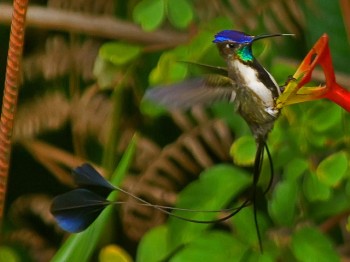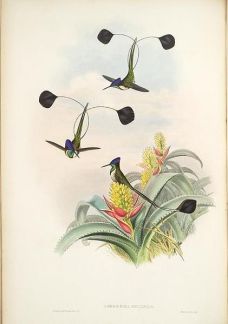Peru’s Marvellous Hummingbird
(from Creation Moments)
In that day the LORD of hosts will be for a crown of glory and a diadem of beauty to the remnant of His people. (Isaiah 28:5)
In 1835, when scientists first saw Peru’s most unusual hummingbird, they were so overcome with its beauty that they gave it the name “Marvellous.” This little bird treats the eye to iridescent green, yellow, orange, and purple feathers. But its most unusual feature is its tail. While most birds have eight to twelve tail feathers, the Marvellous hummingbird has only four. Two of these are long, pointed, thorn-like feathers that don’t seem to help much in flying or landing. The other two feathers are truly marvellous. They are six inches long, three times the length of the bird’s two-inch body. On the end of these two long narrow feathers are large feather fans that nearly equal the surface area of its wings.
Astonishingly, the Marvelous hummingbird has complete control of these feathers. At rest, the bird perches with these two feathers hanging down an inch or so from its body, and then crossing them until they are horizontal. In flight and landing they provide remarkable maneuverability. During mating, the hummingbird moves them as semaphores. Interestingly enough, evolutionists admit that they are stumped as to why these unusual feathers should have evolved.
One look at our creation clearly shows that our Creator appreciates beauty. But even the beautiful Marvelous hummingbird is but a poor and cloudy hint of the beauty of our Creator Himself.
Prayer:
Dear Father, help me treat the beauty You have created as You would have me to do. Let me be filled with thanksgiving to You for it, and let it remind me that You are the source of all that is truly beautiful. In Jesus’ Name. Amen.
Notes:
Crawford H. Greenewalt. The Marvelous Hummingbird Rediscovered. National Geographic, Vol. 130, No. 1. P. 98-101.”
*
Lee’s Addition:
This was originally done in 2010, but needs to be re-blogged again. [Which I did in 2014, It’s now 2019, time for it again.] Also, the YouTube above was added. It is astonishing to watch the little bird in action. Thanks to one of our readers who found the video to add to their site. See The Vine Vigil.
The Marvellous Hummingbird is now the Marvelous Spatuletail (Loddigesia mirabilis). It is in the Hummingbird Family (Trochilidae) and is part of the Apodiformes Order.
The Marvelous (also Marvellous) Spatuletail (hummingbird), Loddigesia mirabilis, is a medium-sized (up to 5.9 in/15 cm long) white, green and bronze hummingbird adorned with blue crest feathers, a brilliant turquoise gorget, and a black line on its white underparts. It is the only member of the monotypic genus Loddigesia.
A Peruvian endemic, this species is found in the forest edge of the Río Utcubamba region. It was first reported in 1835 by the bird collector Andrew Matthews for George Loddiges. The Marvellous Spatuletail is unique among birds, for it has just four feathers in its tail. Its most remarkable feature is the male’s two long racquet-shaped outer tail feathers that cross each other and end in large violet-blue discs or “spatules”. He can move them independently.
Information gathered from Creation Moments, Wikipedia, and YouTube.
*



It’s absolutely amazing to me that they don’t get these long wings caught on something. Leave it to God to create something this astonishing just because He wants to and can. Of course, evolutionists can’t explain it. They have no concept of a God who likes to do things like this for the fun of it. :)
LikeLiked by 1 person
Just so you know, those are tail feathers, not wings. :)
LikeLike
Oh, yeah, I did read that, but I guess in my mind it’s all apparatus that helps them fly better. However, it might be an insult to the bird to refer to them as wings. I guess it would be sort of like calling a Peacock’s tail feathers wings, wouldn’t it? :)
LikeLiked by 1 person
:)
LikeLike
Beautiful
LikeLiked by 1 person
Astonishing!!
LikeLiked by 1 person
Marvelous it is, and wow what an amazing artistry our God has Lee! It appears to me in my observation, these unusually long streamer tails may have something to do with increasing balance in flight. The Tropic birds use their streamers to assist in their acrobatic courting rituals. Interesting post Lee, thanks for sharing. Loved the video!
LikeLiked by 1 person
Thanks and you are welcome. God is AMAZING!!! I have enough trouble not getting my coat caught in the car door. :)
LikeLiked by 1 person